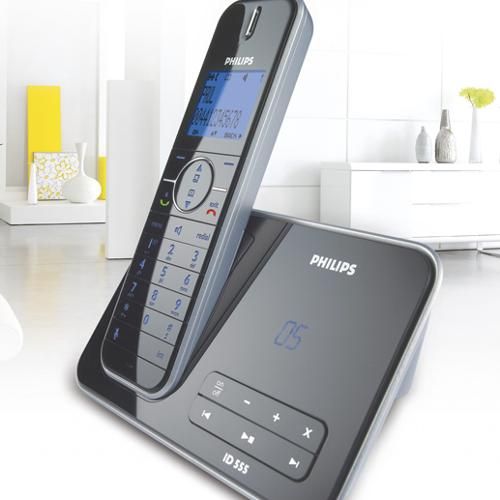Landline phones are still very much part of the domestic scene, refusing to roll over and let the mobile dominate. So can the ID555, winner of an iF Product Design Award in 2008, impress?
The ID555 follows the fairly standard cordless phone practise of pairing up a answering machine base station with a cordless handset. Both have been interestingly designed, benefiting from Philips’ attention to detail, resulting in a package that compliments your modern lifestyle.
The handset itself is rather slim in the hand (144 x 43 x 14.5mm), and very light, with a black gloss frontage. The pearlescent back wraps around the side to edge the handset, giving it a sophisticated look. A small 1-inch screen sits atop a fairly typical layout of keys, all neatly backlit in blue. Compared to a modern mobile phone the display is nothing to get excited about, providing five lines of text and a range of status icons.
The keypad is flat, but the keys are of a size that makes them easy to press, with a nice positive action to each key press, with a distinct click. The central rows of keys provide the normal shortcuts and call buttons, meaning everything is easy to get to. Unlike a mobile phone, the ID555 isn’t packed with lots of features and there is little here to confuse.
The base station follows the same neat design lines, with a gloss black front and pearlescent back, which wraps around the front giving a hint of the signature flare that Philips adds to their audio and TV designs. It is compact, neat, and feels reassuringly well-built.
In the cutout where the handset rests on the base you’ll find a button that operates the page function, meaning you can ring the phone, either to find it, or to alert someone else that you want it, or them, back. As the ID555 also features an answering machine, you’ll find the controls here for that too, although with many telephone providers supplying this feature for free, you might find you never use it.
If you do, you’ll find an impressive 30 minutes of message time, as well as an indicator on the base that lets you know how many messages you have.
The handset also does a good job of keeping track of your calls received and made, and it is really easy to add callers into the address book from the call list, so if you don’t fancy adding all the numbers and names in manually, then you can build up your most-called list pretty quickly over a couple of weeks. The memory will hold 200 entries, whilst the phone will remember 50 calls, and also gives you 10 redial options. There are also the normal speakerphone and alarm clock functions.
We found that calls were clear and no problems were reported when making or receiving calls. Despite plenty of wireless devices in the vicinity, there was no crackle or signal interference. This is also a GAP compatible handset, so will integrate with other GAP phones you may have. Like other phones you’ll find an indoor range of about 50 metres and an outdoor range of 300 metres.
Our quick take
Like other phone manufacturers, Philips are keen to push the ID555 as a green product, pointing out that it has been ecologically designed, with the power pack consuming 50% less than a standard supply, as well as an intelligent regulation of transmission power based on the distance of the handset from the base.
There are a number of ringtones, which we found to be sensible rather than gimmicky, and the signature Philips "sense and simplicity" tone a nice touch and providing audible confirmation that you have just replaced the handset on the base.
Philips lives up to its name with the ID555 as the phone is easy to use, feels like a good quality product, and looks smart.

Philips ID555 telephone - 4.0 / 5
| FOR | AGAINST |
|---|---|
|
|
To recap
Philips lives up to its name with the ID555 as the phone is easy to use, feels like a good quality product, and looks smart
